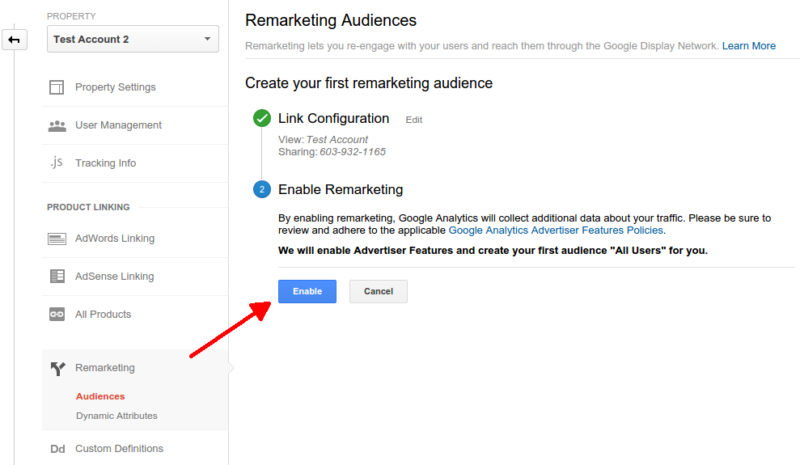Using Remarketing in Google Analytics: A Comprehensive Overview
Taking advantage of remarketing in Google Analytics offers businesses a strategic edge in getting to out to possible clients. This guide will lose light on the crucial actions included in utilizing the full potential of remarketing in Google Analytics, leading to boosted advertising results.
Understanding Remarketing in Google Analytics
Remarketing in Google Analytics permits companies to tactically target individuals who have actually previously connected with their site or mobile app. By leveraging information from Google Analytics, services can create tailored remarketing checklists based on user behavior, such as web pages gone to, actions taken, or details goals attained. This powerful tool allows companies to re-engage with users that have revealed rate of interest in their product and services, ultimately raising the possibility of conversion.
Comprehending the various sorts of remarketing strategies is critical for a successful project - What Is “Remarketing” In Google Analytics?. Google Analytics provides numerous alternatives, consisting of conventional remarketing, dynamic remarketing, and remarketing checklists for search ads (RLSA) Each type offers a special function and can be tailored to fulfill particular marketing purposes
Furthermore, assessing the performance of remarketing campaigns is necessary for maximizing results. Google Analytics provides useful understandings into the efficiency of various remarketing methods, permitting businesses to make data-driven decisions and refine their targeting approach. By continuously keeping an eye on and readjusting remarketing efforts based on analytics data, businesses can take full advantage of ROI and drive success in their advertising initiatives.
Setting Up Remarketing Campaigns

After setting up target market listings, the following action is to connect Google Analytics with Google Ads. By linking these 2 systems, companies can seamlessly move audience checklists from Google Analytics to Google Ads for remarketing objectives. This assimilation enables for more specific targeting and much better project performance.
Once the accounts are connected, businesses can develop remarketing campaigns in Google Advertisements making use of the target market details formerly defined in Google Analytics. These projects can be customized with details ad creatives, messaging, and bidding approaches to successfully re-engage with past site visitors and drive conversions. By complying with these actions, services can leverage the power of remarketing to boost their marketing initiatives and enhance ROI.
Making Use Of Audience Division Techniques

Predefined sectors in Google Analytics allow you to promptly analyze typical audience classifications fresh users, returning individuals, or individuals that completed a certain objective on your web site. moved here Custom-made segments, on the various other hand, allow you to develop unique sections based on details requirements that are important to your service purposes. Dynamic remarketing checklists immediately change based upon user habits, revealing personalized ads to individuals that have actually engaged with your website particularly ways.
Studying Remarketing Performance Metrics
Upon evaluating the performance of remarketing campaigns in Google Analytics, the analysis of key performance metrics offers important insights into audience involvement and conversion rates. By diving right into metrics such as click-through prices (CTR), conversion rates, cost per acquisition (CPA), and return on ad invest (ROAS), marketers can determine the success of their remarketing initiatives. CTR indicates the percent of customers that clicked the ad after seeing it, showing the advertisement's importance and allure. Conversion rates measure the percent of individuals who finished a desired action, such as purchasing, after clicking on the ad. CPA discloses the average price sustained for each conversion, helping evaluate campaign success. ROAS, on the various other hand, measures the profits generated for every buck invested in advertising and marketing. Assessing these metrics allows marketers to enhance campaigns, refine target market targeting, and allot budget plans efficiently to boost general remarketing performance.
Optimizing Remarketing Methods
When refining remarketing strategies in Google Analytics, focusing on target market division is paramount for accomplishing project success. By dividing your audience right into details segments based on their habits, demographics, or rate of interests, you can customize your ads a lot more efficiently to each group. This targeted technique raises the likelihood of involving users who have currently revealed interest in your services or products, resulting in higher conversion rates.
One more crucial aspect of enhancing remarketing methods is continually screening and refining your campaigns (What Is “Remarketing” In Google Analytics?). A/B testing different ad creatives, messaging, or offers can aid you recognize what reverberates best with your audience and drives the most conversions. By evaluating the performance of these examinations in Google Analytics, you can make data-driven decisions to enhance your remarketing efforts even more
In addition, leveraging vibrant remarketing can dramatically boost your project results. This function allows you to reveal tailored advertisements to customers based on their past interactions with your site, showcasing product and services they have actually formerly checked out. By providing customized material to users based on their weblink interests and behaviors, dynamic remarketing can help increase involvement and drive conversions.
Verdict
To conclude, using remarketing in Google Analytics check my site is a calculated method to target users that have actually previously involved with an internet site. By developing tailored audience listings and utilizing target market segmentation techniques, organizations can enhance remarketing projects for boosted conversion rates. Evaluating efficiency metrics and continuously maximizing techniques are critical for making the most of the performance of remarketing efforts.
Google Analytics supplies numerous choices, consisting of conventional remarketing, dynamic remarketing, and remarketing listings for search advertisements (RLSA)After setting up target market lists, the following step is to link Google Analytics with Google Advertisements. By linking these 2 platforms, organizations can seamlessly move target market checklists from Google Analytics to Google Advertisements for remarketing objectives.Once the accounts are connected, organizations can create remarketing campaigns in Google Advertisements utilizing the target market lists previously specified in Google Analytics.When refining remarketing strategies in Google Analytics, concentrating on target market division is paramount for accomplishing project success.